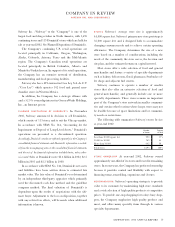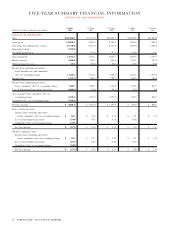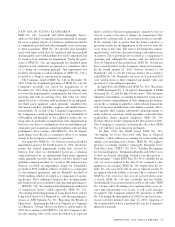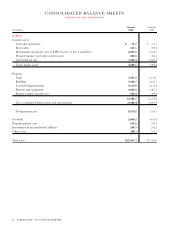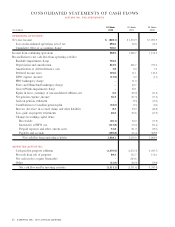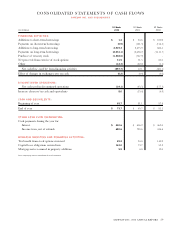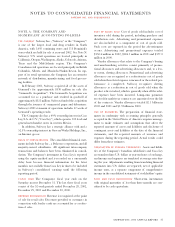Safeway 2002 Annual Report Download - page 23
Download and view the complete annual report
Please find page 23 of the 2002 Safeway annual report below. You can navigate through the pages in the report by either clicking on the pages listed below, or by using the keyword search tool below to find specific information within the annual report.
SAFEWAY INC. 2002 ANNUAL REPORT 21
WORKERS’ COMPENSATION The Company is primarily self-
insured for workers’ compensation, automobile and general
liability costs. It is the Company’s policy to record its esti-
mated self-insurance liability, as determined actuarially,
based on claims filed and an estimate of claims incurred but
not yet reported, discounted at a risk-free interest rate. Any
actuarial projection of losses concerning workers’ compen-
sation and general liability is subject to a high degree of vari-
ability. Among the causes of this variability are
unpredictable external factors affecting future inflation
rates, discount rates, litigation trends, legal interpretations,
benefit level changes and claim settlement patterns. An
example of how change in discount rates can affect
Safeway’s reserve occurred in 2002 when a 100-basis-point
reduction in the Company’s discount rate, based on changes
in market rates, increased its liability by approximately
$9.0 million.
The majority of the Company’s workers’ compensation
liability is from claims occurring in California. California
workers’ compensation has received a significant amount of
attention from the state’s politicians, insurers, employers and
providers, as well as the public in general. Recent years have
seen an escalation in the number of legislative reforms, judi-
cial rulings and social phenomena affecting workers’ com-
pensation in California. Some of the factors that may affect
the Company’s reserve estimates include changes in benefit
levels and medical fee schedules. In 2002, the State of
California passed AB-749 which increases the maximum
weekly temporary-disability rate beginning in 2003. Weekly
benefits are calculated as a function of the hourly pay rate
and the average number of hours worked. The law also has
several cost containing measures, such as the establishment
of some medical fee schedules and abolishment of the treat-
ing physician presumption. The impact of the increase in
benefits on Safeway is mitigated by the high ratio of part-
time workers, who typically qualify for benefit amounts
below the weekly maximum.
The Company’s workers’ compensation future funding
estimates anticipate no change in the benefit structure.
Statutory changes could have a significant impact on future
claim costs. The California Legislature is currently dis-
cussing additional benefit reforms. At this point it is
unknown what, if any, changes will result.
STORE CLOSURES It is the Company’s policy to recognize
losses relating to the impairment of long-lived assets when
expected net future cash flows are less than the assets’ carry-
ing value. For stores closed that are under long-term leases,
the Company records a liability for the future minimum
lease payments and related ancillary costs from the date of
closure to the end of the remaining lease term, net of esti-
mated cost recoveries. In both cases, fair value is determined
by estimating net future cash flows and discounting them
using a risk-adjusted rate of interest. The Company esti-
mates future cash flows based on its experience and knowl-
edge of the market in which the closed store is located and,
when necessary, utilizes local real estate brokers. However,
these estimates project cash flow several years into the future
and are affected by variable factors such as inflation, the
strength of the real estate markets and economic conditions.
EMPLOYEE BENEFIT PLANS The determination of Safeway’s
obligation and expense for pension and other post-retire-
ment benefits is dependent, in part, on the Company’s selec-
tion of certain assumptions used by its actuaries in
calculating these amounts. These assumptions are disclosed
in Note J to the consolidated financial statements and
include, among other things, the discount rate, the expected
long-term rate of return on plan assets and the rates of
increase in compensation and health care costs. In accor-
dance with generally accepted accounting principles, actual
results that differ from the Company’s assumptions are accu-
mulated and amortized over future periods and, therefore,
affect its recognized expense and recorded obligation in such
future periods. While Safeway believes that its assumptions
are appropriate, significant differences in Safeway’s actual
experience or significant changes in the Company’s assump-
tions may materially affect Safeway pension and other post-
retirement obligations and its future expense.
An example of how changes in these assumptions can
affect Safeway’s financial statements occurred in 2002. Based
on the Company’s review of market interest rates, actual
return on plan assets and other factors, Safeway lowered its
discount rate for U.S. plans to 6.50% at year-end 2002 from
7.50% at year-end 2001. The Company also lowered its
expected return on plan assets for U.S. plans to 8.50% at
year-end 2002 from 9.00% at year-end 2001. These rates are
applied to the calculated value of plan assets and liabilities
which results in an amount that is included in pension
expense or income in the following years. When not consid-
ering other changes in assumptions or actual return on plan
assets, the 100-basis-point change in the discount rate alone
will negatively impact 2003 U.S. pension expense by approx-
imately $19.8 million and the 50-basis-point change in
expected return on plan assets alone will negatively impact
2003 U.S. pension expense by $6.5 million.
While changes in assumptions may materially affect the
Company’s future expense, the most significant factor in
determining this amount is the fair value of plan assets at
year end. Not considering any changes in assumptions, a
$100 million change in plan assets in 2002 would impact
2003 U.S. pension expense by approximately $8.5 million.
The fair value of plan assets can vary significantly from year
to year.




